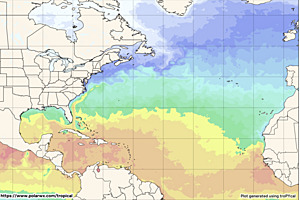It's Thursday November 20, 2025 Dock Quote: “If people wanted...
Dock Quote: “If people wanted...
News From The Village Updated Almost Daily

Post-Tropical Cyclone Imelda Forecaster's Discussion & Computer Models
| ||||||||||||||
Post-Tropical Cyclone Imelda Forecaster's Discussion # |
| A graphic showing several computer modeled projected tracks is at the bottom of this page. |
Post-Tropical Cyclone Imelda Discussion Number 24 NWS National Hurricane Center Miami FL AL092025 1100 AM AST Thu Oct 02 2025 Imelda is no longer a tropical cyclone. Visible satellite images and global model fields indicate that a front extends into the center of the cyclone from the east-northeast, while another frontal feature has developed to the south of the cyclone. This is consistent with overnight microwave data that showed Imelda taking the appearance of an occluded cyclone, as well as recent satellite trends that show the remaining convection is mainly focused along these fronts. Therefore, Imelda is classified as a 65-kt extratropical cyclone this morning, and this will be the final NHC advisory on the system. Post-tropical Imelda is racing toward the east-northeast (075/25 kt) away from Bermuda. The cyclone is expected to turn northeastward on Friday ahead of an amplifying upper-level trough over the northern Atlantic, then turn back toward the east-northeast by Sunday within the mid-latitude westerlies. The track guidance is in much better agreement than yesterday, and the NHC forecast lies near the center of the envelope between the HCCA and TVCA aids. Baroclinic forcing from the upper trough will likely cause the cyclone to remain a large, storm-force low through the weekend. Even though the peak winds are forecast to gradually diminish, a large area of 34- and 50-kt winds will create hazardous marine conditions and large swell that will continue to affect an expansive portion of the western and central Atlantic. Additional information can be found in High Seas Forecasts issued by the National Weather Service, under AWIPS header NFDHSFAT1, WMO header FZNT01 KWBC, and online at ocean.weather.gov/shtml/NFDHSFAT1.php KEY MESSAGES: 1. Gusty winds over Bermuda will gradually subside today. 2. Swells and high surf from Imelda are expected to produce dangerous marine conditions and rip currents along much of the East Coast of the United States and the western Atlantic during the next several days. FORECAST POSITIONS AND MAX WINDS INIT 02/1500Z 33.2N 59.5W 65 KT 75 MPH...POST-TROPICAL 12H 03/0000Z 34.3N 55.0W 65 KT 75 MPH...POST-TROP/EXTRATROP 24H 03/1200Z 36.3N 51.4W 60 KT 70 MPH...POST-TROP/EXTRATROP 36H 04/0000Z 38.9N 49.1W 60 KT 70 MPH...POST-TROP/EXTRATROP 48H 04/1200Z 41.7N 47.6W 55 KT 65 MPH...POST-TROP/EXTRATROP 60H 05/0000Z 44.6N 44.6W 50 KT 60 MPH...POST-TROP/EXTRATROP 72H 05/1200Z 47.1N 40.1W 50 KT 60 MPH...POST-TROP/EXTRATROP 96H 06/1200Z 50.0N 30.5W 45 KT 50 MPH...POST-TROP/EXTRATROP 120H 07/1200Z...DISSIPATED $$ Forecaster Reinhart |
The Forecaster's Discussion above often refers to several computer models. The graphic below includes multiple projected paths, showing what the different computer models indicate. The black line is the NHC (National Hurricane Center) path. This graphic is not an official NHC product. For the official NHC projected path of Post-Tropical Cyclone Imelda click here.

click image for a larger view
For more information about tropical storm computer models click here.



